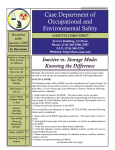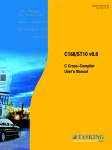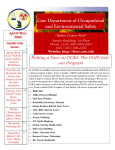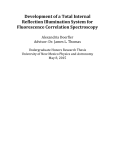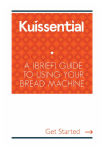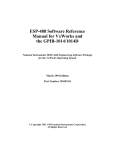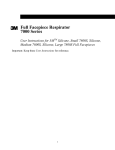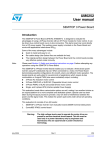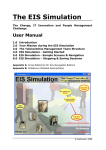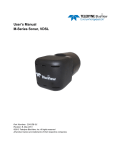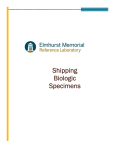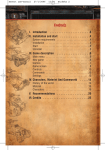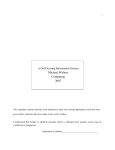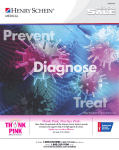Download Case Department of Occupational and Environmental Safety
Transcript
Case Department of Occupational and Environmental Safety March/April 2009 In this issue: Laboratory Sustainability 2 Infectious Miseries 2 During “Flu” Season (con.) Infectious Miseries During “Flu” Season (con.) 3 Infectious Miseries During “Flu” Season (con.) 4 RAM Storage— Clarifications 4 Disposal of Chemicals in Sanitary Sewers (Drains)— Reminders 5 Receipt of Radioactive Material— Reminders 6 Ultraviolet Lights – Use and Maintenance 7 Eating Food in the Lab: An Illegal Habit Where is DOES? 8 Upcoming Training Sessions 810 “SAFETY COMES FIRST” Service Building, 1st Floor Phone: (216) 368-2906/2907 FAX: (216) 368-2236 Website: http://does.case.edu Infectious Miseries During “Flu” Season It’s “flu Season” and every year a number of members of our community suffer from diseases that tend to be generically referred to as “flu.” The Influenza virus (a.k.a., the “flu”) does not cause most of the illnesses suffered by individuals on campus, yet this misunderstanding causes many members of our community to avoid getting a flu shot because they don’t think they are effective. That is especially unfortunate (particularly this year) when the influenza strain that is most prevalent does not respond to antivirals. In this season of close-quarter living, many of us also contract diseases that are referred to generically as “stomach flu.” Some of these diseases tend to be attributed by many people to “food poisoning,” but investigation usually dispels this source as the cause of such illnesses at this time of year. On the other hand, exposure to many of the agents that do cause common winter diseases like rhinoviruses (a.k.a., the common cold) and norovirus (a.k.a., various gastrointestinal miseries) can be avoided by better cleanliness habits and disease avoidance behaviors on the part of all of us. For instance, wash your hands carefully after using bathrooms or touching commonly exposed surfaces, clean surfaces exposed to many different hands, stay home when you are ill, and keep your distance from individuals showing upper respiratory symptoms or declaring themselves to be ill. To clarify the principle causes of this season’s diseases, DOES asked Eleanor Davidson, MD, the Director of our University Health Service to comment on “flu” and this winter’s most common diseases. Her response follows on page 2. (continued on page 2) Page 2 Case Department of Occupational and Environmental Safety Laboratory Sustainability In order to help create a sustainable culture at Case the DOES is implementing a new recycling program. Laboratory plastics can now be recycled as long as they are handled properly. In order to prepare plastic chemical bottles, media bottles, old carboys, or any other plastic marked with a #1, #2, #3, or #5 recycle code you must first deface all chemical labels. The best way is to take a permanent marker and blackout any lettering on the outside of the bottle. Next, the lids can be disposed of in the regular trash and the bottle should be triple rinsed to ensure that no residue is left behind. Taking these steps helps to ensure that personnel removing the plastics are safe. “Most plastics marked with the appropriate recycle code can recycled. This does not include pipette tip boxes or inserts.” As mentioned above, most plastics marked with the appropriate recycle code can recycled. This does not include pipette tip boxes or inserts. Many distributors like Laboratory Product Sales and USA Scientific will take pipette tip boxes and inserts which you have purchased from their company. In order to obtain a recycle bin for your laboratory please contact Fred Peck of Custodial Services at 368-1075. All other questions can be directed to Jon Birkes in D.O.E.S. office at 368-1519. Infectious Miseries During “Flu” Season (continued from page 1) There are two predominant infections – and sometimes both of these are referred to informally as “flu.” True influenza (the illness prevented by yearly flu shots) is: - high fever - sore throat - cough - muscle aches - sweating - headache Ask anyone who’s had it: It is not just a bad cold and it doesn’t go away quickly. The good news: the flu shot this year is good at preventing illness. (You can still get one at the Health Service for $15). The bad news: the antiviral drugs are ineffective this year. Most all of the influenza that has been seen in the US has been resistant to Tamiflu. Treatment has centered on (continued on next page) Case Department of Occupational and Environmental Safety Page 3 Infectious Miseries During “Flu” Season (continued from page 2) …ibuprofen to reduce the fever, headache and muscle aches, as well as plenty of fluids. What is the other kind of “flu” (the so-called “stomach flu”)? This is often caused by Norovirus. A virus that causes: - nausea and vomiting (often many times) - diarrhea - aches all over - low grade fever - occasionally headaches Again, this is NOT INFLUENZA. The Norovirus may develop within 24 to 48 hours of exposure to the virus. The good news: As bad as you feel when you’re throwing up, the illness usually only lasts 24 hours. The vomiting only lasts about 6 to 12 hours. Key points in treatment: 1. Try to sleep through the worst part (the first 6 hours). 2. Once the vomiting has stopped, don’t take anything by mouth for another 2 hours (try napping again). 3. Then begin with only sips of water or suck on a piece of ice (if you drink more, you may throw it all up and have to start the cycle again). 4. If that stays down, go to a sip of water or ginger ale every 10 minutes. Other liquids that work well would be Gatorade, tea with honey, or clear broth. 5. Next add easily digested foods, like plain rice, apple juice, saltines, or toast and jelly. 6. Next add applesauce, cooked vegetables, chicken, or eggs. The last things to add would be dairy products and red meat. Note: Adults will not get significantly dehydrated by 12-24 hours of vomiting and diarrhea (unless they have a medical illness like diabetes). You don’t need to go to the emergency room for vomiting like this. You can stay at home or in your room more comfortably than traveling elsewhere. Students can obtain Pepto-Bismol from Residence Life staff who have this medicine in their First Aid kits. PeptoBismol can help to settle your stomach. Norovirus is very contagious. The virus aerosolizes easily with vomiting (spreads through tiny droplets in the air). When you’re feeling better, take a shower and wash all your clothing (and sheets and towels). Good hand washing is also helpful. (continued on page 4) “What is the other kind of ‘flu’ (the so-called ‘stomach flu’)? This is often caused by Norovirus. Again, this is NOT INFLUENZA” Page 4 Case Department of Occupational and Environmental Safety Infectious Miseries During “Flu” Season (continued from page 3) “Students with Norovirus infections are not encouraged to come to the Health Service, but they can call 368-2450 and speak to one of the nurses for advice.” Students with Norovirus infections are not encouraged to come to the Health Service, but they can call 368-2450 and speak to one of the nurses for advice. Others should follow this advice by providing themselves with supportive treatment at home. The Health Service does want to see students with high fever and they can make own appointments online @ <https://myhealthconnect.case.edu>. Or you can call 368-4539 to schedule a time to be seen. Others should consult a physician if their symptoms last more than a few days or develop into intractable respiratory discomfort. For more information on Influenza, please visit the CDC @ (http://www.cdc.gov/ flu/) AND For more information on Norovirus, please visit the CDC @ (http://www.cdc.gov/ ncidod/dvrd/revb/gastro/norovirus-qa.htm). RAM Storage—Clarifications Guidelines for radioactive materials (or RAM) storage are established by the Ohio Department of Health, Bureau of Radiation Protection. Even if only small millicurie quantities are involved in a typical laboratory research setting, you should rely on any of the following methods (or a combination of several methods): • • • Direct supervision of RAM by appropriate “licensee” staff Locked doors to all work spaces when the area and materials are unattended Placement of RAM in a locked refrigerator, freezer, or storage cabinet when not actively used This list is not comprehensive. It is intended to be representative. When the Bureau of Radiation Protection inspects laboratories, they use a performance-based approach. This means that BRP checks that radioactive materials are not left unattended in an open lab or work area. If the materials are properly secured, then the measures of the lab being inspected are deemed satisfactory. If you have any questions about radioactive material storage, please contact DOES at 368-2906. Case Department of Occupational and Environmental Safety Page 5 Disposal of Chemicals in Sanitary Sewers (Drains)—Reminders As you are probably already aware, all hazardous wastes are regulated by the EPA under the Resource Conservation and Recovery Act or RCRA. In general, RCRA regulations do not permit the disposal of chemicals in drains, except for the items listed below: 1. Inorganic acids and bases that have a pH between 5 and 10. These pH limits are imposed by regional sewer regulations. Sewer disposal is permitted provided no other regulated chemical is present. Neutralization is permitted to change the pH to within acceptable limits if it is written into the experiment’s protocol. 2. Aqueous buffer solutions containing no regulated materials or biohazardous threat (e.g. common salt solutions or tissue culture media). Such solutions may contain millimolar concentrations of common biochemicals, buffers, serum byproducts, or cell metabolites. When in solution common salts (chlorides, bromides, bicarbonates, citrates, phosphates, sulfates, acetates) of sodium, potassium, magnesium, ammonium, and calcium may be disposed in the sanitary sewer. 3. Aqueous High Performance Liquid Chromatography (HPLC) solutions or other solutions containing less than 24% ethanol, propanol, or isopropanol (no other alcohols). The 24% limit is based on flammability of the alcohol. HPLC solutions containing any amount of acetonitrile or other organic solvents must be disposed through Safety Services. In University Hospital, contact UH Safety (844-1458) to arrange for disposal of these chemicals. 4. Bacteriological and tissue culture media. Such media containing live organisms must be sterilized by autoclaving or another acceptable procedure and must not contain anything other than common biochemicals. Serium byproducts or cell metabolites containing azides or thioglycolate must be disposed by Safety Services or, in University Hospital, by UH Safety. 5. Mixed waste (radioactive waste combined with a solvent or inorganic material). Must be classified by chemical and level of radioactivity before drain disposal. Refer to the Radiation Safety Laboratory User Manual for disposal procedures and acceptable limits. The manual is available on the DOES website (http:// does.case.edu) under “Forms/Manuals.” 6. No more than unavoidable traces of highly toxic organic chemicals, such as those found on glassware surfaces, of either synthetic or biological in origin, should be allowed in the sanitary sewer. NOTE: Hazardous waste cannot be diluted with a material which is not a waste (e.g. fresh water) in order to bring them to concentration suitable for drain disposal, unless this dilution is part of an experimental procedure. Always call Safety Services (368-2907) first if you have questions on proper disposal of chemical waste. “Hazardous waste cannot be diluted with a material which is not a waste (e.g., fresh water) in order to bring them to concentration suitable for drain disposal, unless this dilution is part of an experimental procedure.” Page 6 Case Department of Occupational and Environmental Safety Receipt of Radioactive Material— Reminders When a package of radioactive material is received in Shipping & Receiving, the RSOF is notified. The packing slip, as well as the CASE RAM Package Receipt Form will be attached to the package when it is delivered to the lab. A dated inspection label is also attached to the package indicating that it was inspected by the RSOF. If this sticker or the CASE RAM Package Receipt Form is missing, inform the RSOF immediately. If the lab orders >1 mCi of radioiodine or > 10mCi of H-3, a label informing them of bioassay requirements will also be attached. The CASE RAM Package Receipt Form RSOF Package Screening Results A specialist from the RSOF will check the package for any surface contamination on the outside of the box, as well as measure dose rates on the surface and at three feet (one meter). If surface contamination exceeds 220 dpm/100cm2, or greater than 0.5 mrem/hr at the surface, the package will be held by the RSOF and the laboratory will be contacted. The packing slip attached to the package will also be checked to ensure that the correct isotope and activity has been ordered. A signature and the time and date that the package was checked are filled in, as well as the purchase order number and the date received. Laboratory Use for Package Survey Results The individual receiving the package in the laboratory completes this part of the form. The package MUST be surveyed by the lab on the same day that the package is received. Probe readings, as well as wipe tests, must be performed on the exterior of the box, and on the inside of the Styrofoam container containing the stock vial. Please be certain you do not take probe readings if the vial is in the box. If your shipment contains 3H, only a wipe test is performed. Perform a wipe test on the outside of the stock vial in order to ensure the vial is not leaking. Determine the activity of the wipe with an appropriate counting device. Wipes from a package containing 32P can be checked using a survey meter. Wipes from packages containing any other isotopes must be checked using the LSC. Record the activity in units of dpm/100cm2. Please include all survey meter information on the form. Sign your name, write in the date that the package was surveyed, and place this form in a notebook for future RSOF compliance reviews. Assigned Number Equipment Description Case ID 1 Kenmore Refrigerator 98-1345 2 Incubator N/A Disposition Disposal (acct #:1234567) Relocate Location BRB 100 BRB 100A If you want to use your own package receipt form, please be sure to include the same information that is required on the form generated by the RSOF. Attach your form to the RSOF form and place these in a notebook for future RSOF compliance reviews. Always call Radiation Safety (368-2907) first if you have questions on the proper procedure for receiving radioactive material. Case Department of Occupational and Environmental Safety Page 7 Ultraviolet Lights— Use and Maintenance Ultraviolet (UV) radiation includes that portion of the radiant energy spectrum between visible light and X-rays (approximately 3900 to 136 angstrom units). Under certain conditions, including radiation intensity and exposure time, UV radiation will kill many types of microorganisms – its greatest effectiveness being against vegetative forms of organisms. UV light is not a sterilizing agent, except in certain exceptional circumstances. Rather, it is used to substantially reduce the number of microorganisms on surfaces and in the air. Guidelines Low-pressure mercury vapor lamps, which emit 95% of their radiation in the 2537 angstrom unit region, are generally used for germicidal purposes. These lamps are used to reduce the number of microorganisms on exposed surfaces and in the air. Since such factors as lamp age and dust accumulation contribute to decreased efficiency of these lamps, and since care is required to maintain and use them properly and safely, the following guidelines have been developed: 1. Laboratories shall perform periodic intensity testing of all UV installations. UV lamps in constant use should be replaced every six months. NOTE: UV lights often continue to emit blue light after effective energy output has fallen well below a useful range. Periodic monitoring with an appropriate light energy meter is necessary to verify proper output of UV light sources. Contact Radiation Safety (368.2906) to perform UV light monitoring. 2. UV lamps in air locks and door barriers will be turned on continuously. Skin or eye protection is not usually required for persons walking through these areas. Protection is required, however, for persons exposed to the radiation for longer than a few seconds. UV lamps in BSCs will be turned on only when the cabinet is not in use. The lamps in the BSC lethal chamber above the filters are turned on automatically when the blower is turned on. Personnel must wear PPE (goggles, caps, gowns, and gloves) or turn off the lights before entering laboratories, animal rooms, or exposed spaces which have UV installations. 3. All UV lamps except those located in the BSC lethal chamber above filters must be cleaned at twoweek intervals, or more often if located in an unusually dusty area. The lamps should be turned off and wiped with a soft cloth moistened with alcohol. Cleaning is the responsibility of the personnel in charge of the laboratory. Cleaning dates should be logged on a card and attached to the installation. 4. Special problems concerning use, cleaning, or installation of UV lamps should be referred to Radiation Safety (368.2906). ************************************************************************************ Page 8 Case Department of Occupational and Environmental Safety Eating Food in the Lab: A Dangerous and an Illegal Habit While a little snack or drink may seem harmless, in the lab these items can be deadly. Ingestion is the primary means by which chemical, radiological, and biohazardous materials enter the human body. Federal and Ohio laws prohibit food and drinks in ALL laboratory areas containing these materials. OSHA Reg.29 CFR 1910.1450, page 494, E.1.d. specifically states, “Avoid eating, drinking, smoking, gum chewing, or application of cosmetics in areas where laboratory chemicals are present.” This includes standard laboratory, warm rooms, equipment rooms, common use and other laboratory-related areas. Food, drinks and their corresponding containers found in Case laboratory areas will be confiscated and disposed of as biohazardous waste. Moreover, anyone found in violation of this law will by reported to the Chairman and primary investigator in charge of the area where the policy violation occurred. Violation of this law and Case policy is a serious offense and can result in suspension of laboratory activities and privileges. All food or drink used for research purposes (dried milk, iodized salt, etc.) must be clearly labeled as follows: “NOT FOR HUMAN CONSUMPTION” Safety should be the first priority of all members of the Case research community. If you note violations of this policy, please respond promptly by contacting DOES at 368-2907. Where is DOES? If you're new to Case (or simply haven't been to visit us yet), we are located in the Service Building on the 1st floor just off Circle Drive between the Health Sciences Library to the east and the Powerhouse Building to the west. For clarity, call x2906/2907 or check our website (http://does.case.edu.) for an interactive map before your visit. Keep in mind that much of the information and services (e.g., Safety Services manuals and forms, upcoming training sessions, online training sessions, past newsletters, etc.) that DOES provides can be found conveniently online at (http://does.case.edu) at any time. Upcoming Training Sessions* IMPORTANT NOTE: While all laboratories must attend training at DOES, labs must hold specific training in the CHP and ECP as it pertains to the actual work they do. Labs will also need an outline of the CHP and ECP training and a sign in sheet to accompany. Store the sign-in sheet and outline with the CHP and ECP. IT will be asked for during lab inspections. Case Department of Occupational and Environmental Safety Page 9 Upcoming Training Sessions* New Hazard Communication (Right-to-Know) Training Retraining is required annually. DOES Small Meeting Room - Service Building 1st Floor PREREGISTRATION IS REQUIRED! - Please call 368-2907 New Radiation Safety Training Retraining is required annually. DOES conference room - Service Building 1st Floor PREREGISTRATION IS REQUIRED ! - Please call 368-2906 New Laser Safety Training Retraining is required annually. DOES conference room - Service Building 1st Floor PREREGISTRATION IS REQUIRED ! - Please call 368-2906 FOR THE FOLLOWING CLASSES: Laboratory Safety Retraining Regulated Chemical Retraining Hazard Communication (Right-to-Know) Retraining Bloodborne Pathogen Retraining Radiation Safety Retraining Laser Safety Retraining Respirator Safety Retraining Please retrain on the Internet at <http://does.case.edu> and click on Training. Print test and fax or mail it to the DOES office. If your training is more that one year overdue, then you must attend the training class in person and cannot retrain online. FOR THE FOLLOWING CLASSES: New Laboratory Safety Training New Regulated Chemical Training (Formaldehyde, Benzene, Methylene Chloride, Vinyl Chloride, etc.) New Bloodborne Pathogen Training New Respirator Safety Training New BSL-3 Safety Training Retraining is required annually. DOES Conference Room - Service Building 1st Floor PREREGISTRATION IS REQUIRED! - Please call 368-2907 *As always, consult our website (http://does.case.edu) for a full schedule of training sessions (continued on page 10) Please remember that our updated DOES website provides many resources to meet your safety needs. The DOES website (http://does.case.edu/) includes all of the following resources: • Safety Services Manuals and Forms • Archived DOES Newsletters • Training Class Schedules • Staff Information • MSDS • Important Safety Links • Our Mission Statement • Contact Information If you have any questions about our website, please feel free to contact us at ext. 2906/2907 DOES STAFF W. David Sedwick, Ph.D., (wds), Director and RSO Felice Thornton-Porter (fst2), Q.A. Specialist II Shirley Mele (smm5), Manager/Ergonomic Coordinator Gwendolyn Cox-Johnson (gxc13), Dept. Assistant II Jason May (vfl), Dept. Assistant II Ronald Tulley (rxt33), Technical Writer Chemical Safety Marc Rubin (mdr6), Assistant Director, EH&S Robert Latsch (rnl2), Specialist I Bill DePetro (wjd11), Specialist II Tom Merk (tlm8), Specialist II Jon Birkes (jon.birkes), Specialist II Edwin Filppi (edwin.filppi), Specialist I Mary Ellen Scott, Ph.D. (mas35), Specialist I Radiation Safety Karen Janiga (kej2), Assistant Director, Assistant RSO Yelena Neyman (yxt13), Specialist I Charles Greathouse (cxg118), Analyst Programmer I Joe Nikstenas (jen), Operations Supervisor, Specialist II Victoria Cook (victoria.cook), Specialist I Sylvia Kertesy (sylvia.kertesy), Specialist I Department of Occupational and Environmental Safety Case Western Reserve University (216) 368-2906/2907 FAX: (216) 368-2236 (E-mail) [email protected] (www) http://does.case.edu










